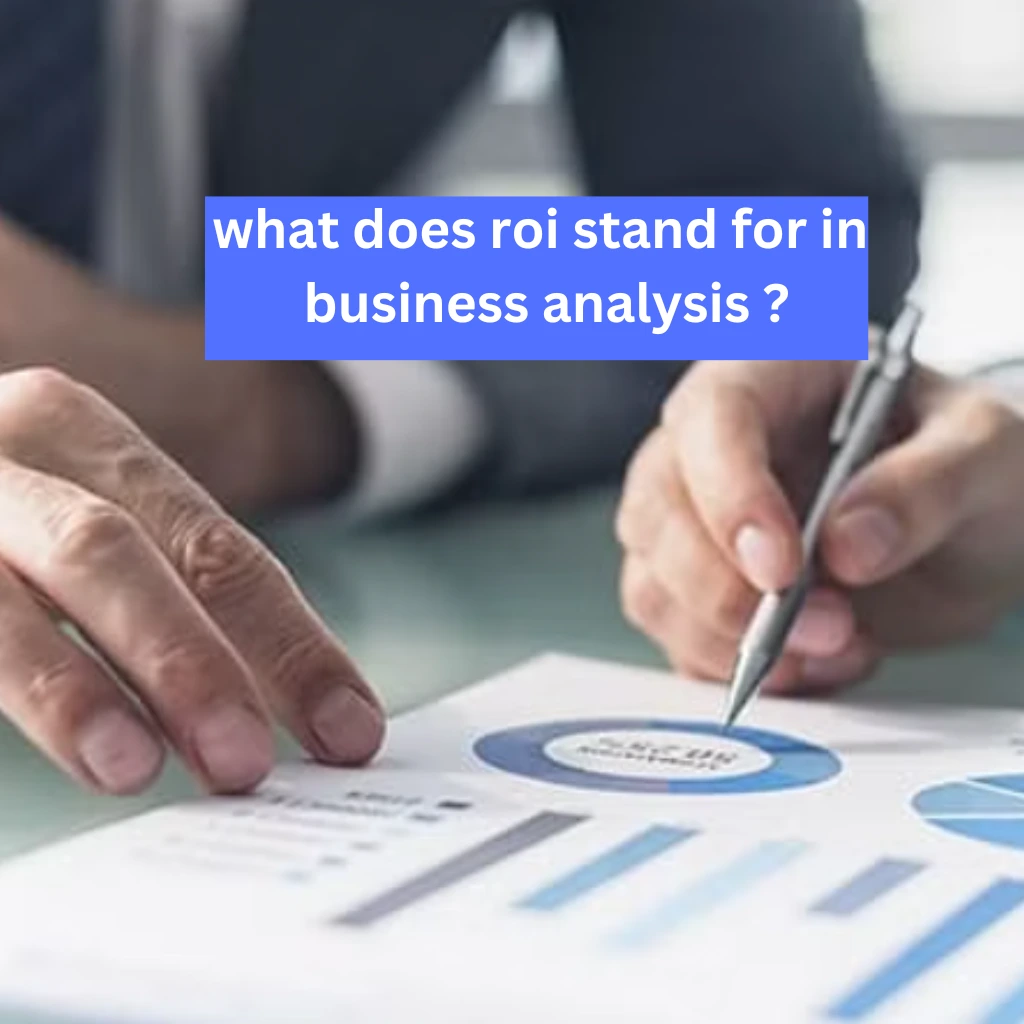Introduction | what does ROI stand for in business analysis ?
Decision-makers in the ever-changing corporate environment are always looking for instruments and metrics to measure the effectiveness of their initiatives. Return on Investment (ROI) is one such important statistic. This blog will explore the nuances of return on investment (ROI) in business analysis, providing insight into its meaning, use, and influence on strategic choices.
Understanding ROI
ROI, or return on investment, is a key performance metric that’s used to assess how much money was made in comparison to how much was spent. Essentially, return on investment (ROI) gives organizations a way to quantify profitability and evaluate the effectiveness of their efforts. ROI may be easily calculated using the following formula: (Net Profit / Cost of Investment) times 100.
It’s essential to take into account both financial and non-financial aspects in order to do an exhaustive ROI analysis. Non-financial ROI considers expenses, intangible advantages, and even social and environmental effects. Financial ROI, on the other hand, focuses on monetary returns and profitability evaluation.
ROI in Business Decision-Making
Role of ROI in Strategic Planning
Strategic planning relies heavily on return on investment (ROI), which directs organizations in allocating resources to optimize profits. Knowing the possible return on investment (ROI) before launching a new product, breaking into a market, or making a technological investment helps decision-makers in setting priorities that support company objectives.
How ROI Influences Investment Decisions
The projected return on investment influences all types of investment choices, no matter how large or little. Before allocating resources, businesses consider the possible financial advantages in relation to the costs and hazards involved. ROI analysis gives a clear image of the expected returns, which helps in decision-making.
Balancing Risk and Return in Business Analysis
Delicately balancing risk and return is made easier with the help of ROI analysis. Companies are able to appraise the possible hazards connected to an investment and determine if the anticipated profits outweigh the degree of risk. It takes a risk-return analysis to keep a strong and long-lasting company plan.
Types of ROI in Business Analysis
Financial ROI
Calculating Monetary Returns
The main goal of financial ROI is to compute the monetary returns that an investment produces. To ascertain the whole performance and profitability of a company endeavour, it entails evaluating profits, revenues, and other financial benefits.
Assessing Profitability
Return on Investment (ROI) is a useful metric for evaluating the profitability of different projects or commercial endeavours. Organizations may determine which initiatives make the most contributions to their bottom line by weighing the expenditures invested against the financial rewards realized.
Non-Financial ROI
Intangible Benefits and Costs
Non-financial ROI explores intangible costs and benefits whereas financial ROI offers a clear picture of monetary returns. This covers elements that may not have a direct monetary value but yet have a big impact on overall performance, such as staff morale, customer satisfaction, and brand reputation.
Social and Environmental Impact
In a time when corporate social responsibility is crucial, companies are taking the social and environmental effects of their operations into account more and more. Organizations may measure and assess their good contributions to the environment and society with the use of non-financial ROI analysis.
Importance of ROI in Performance Evaluation
Measuring the Success of Business Initiatives
A key indicator of the effectiveness of many business endeavours is return on investment (ROI). Analyzing the return on investment (ROI) of a project, whether it a process improvement initiative, a product launch, or a marketing campaign, reveals what went well and what still needs work.
Tracking ROI Over Time
Investments made by businesses are also dynamic. Organizations may adjust and improve their strategy in response to changing market circumstances, customer trends, and internal variables by monitoring return on investment over time. Efficient resource allocation is ensured by conducting regular ROI evaluations.
Benchmarking and Comparisons
Benchmarking and comparing across various projects or business divisions are made easier with the help of ROI analysis. Businesses may find best practices, spot anomalies, and make well-informed choices about how to allocate resources and improve their strategies by setting standards.
Challenges in ROI Analysis
Identifying and Quantifying Costs
Precisely identifying and measuring all related expenses is a problem in ROI analysis. This covers not just direct financial outlays but also opportunity costs, indirect costs, and hidden costs that might affect the ROI estimate as a whole.
Addressing Uncertainty and Risk
Risk and uncertainty are a part of doing business. These aspects need to be taken into consideration when doing ROI analysis, and decision-makers should exercise caution when evaluating prospective returns or risks. Precise ROI forecasts need strong risk management techniques.
Incorporating Non-Monetary Factors
It might be difficult to place a monetary value on non-financial elements like staff happiness or brand reputation. Although these elements have a major impact on success as a whole, it is difficult to precisely measure them due to their subjective character.
Best Practices for Effective ROI Analysis
Clear Goal Setting
Clearly defined goals are the foundation of any successful ROI study. Whether the goal is to increase income, cut costs, or expand into new markets, organizations need to specify what they want to achieve from their investments. Well-defined objectives provide a structure for precise ROI evaluation.
Accurate Data Collection
The quality of the data gathered determines how accurate ROI analysis is. Businesses must make significant investments in reliable data gathering procedures to guarantee that all data—financial and non-financial—is correct, current, and relevant to the analysis.
Periodic Review and Adjustment
ROI analysis is a continuous endeavour. Companies should periodically examine their investments, reevaluating presumptions, modifying computations, and modifying strategy as needed in light of the changing business environment.
Case Studies
Real-world Examples of Successful ROI Analysis
Effective ROI research has paid off for a number of companies. Case studies will examine how businesses strategically used ROI concepts to produce notable returns on their investments.
Lessons Learned from ROI Failures
Not every company endeavour produces the expected profits. Analyzing situations in which ROI did not meet projected returns offers insightful information about typical traps, allowing companies to grow from their errors and improve ROI analysis techniques.
Future Trends in ROI Analysis
Technological Advancements in Business Analysis
Technological developments will have an impact on ROI analysis in the future. It is anticipated that automation, data analytics, and artificial intelligence would be essential in improving ROI estimates’ precision and effectiveness.
Evolving Metrics and Measurement Tools
The measurements employed in ROI analysis change along with the dynamics of the company. New metrics and measuring instruments that more accurately reflect the complexity of contemporary corporate operations may be developed in the future.
Emerging Approaches to ROI in a Changing Business Landscape
Both the corporate environment and ROI analysis methodologies are always evolving. Examining new trends and creative strategies may offer firms insights into how to remain competitive in a dynamic and ever-changing market.
Conclusion
In summary, return on investment is a critical indicator that influences corporate decision-making around the globe. Through a comprehensive grasp of ROI in business analysis, businesses may make well-informed choices, optimize the allocation of resources, and guarantee the sustainability and long-term success of their endeavours. Promoting a proactive approach to ROI analysis is essential for navigating the complicated corporate environment of today, when strategic decision-making and agility are critical. The future will bring with it changes to the function of ROI in business research, impacting how companies gauge their performance and make plans for a profitable future.
You may interested in:
Elon musk 55 Billion $ package
Elon Musk Won’t Get His $55 Billion Pay Package | What It Means for Tesla’s Future ?






One thought on “what does ROI stand for in business analysis ?”